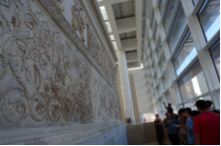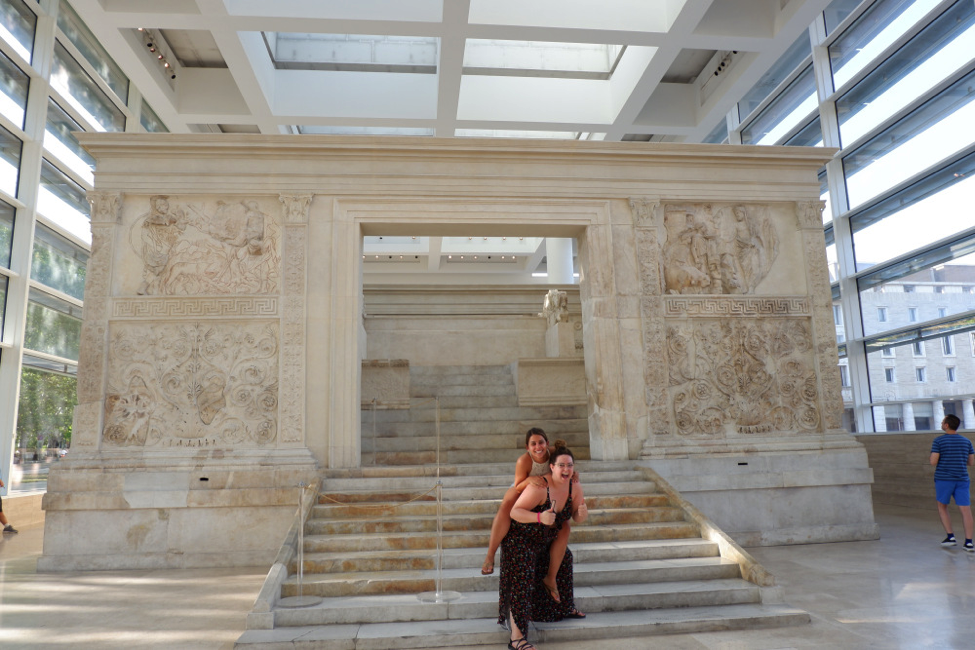Rome | Ara Pacis
by Andrea Zachrich
The Ara Pacis, also sometimes called the Altar of Augustan Peace, is one of my favorite monuments from ancient Rome. It’s a cunning piece of propaganda by Emperor Augustus, and its excavation story is pretty awesome. Being particularly well-preserved, it can tell modern scholars a lot about the imperial imagery and symbols. It’s also very pleasant to visit because the altar is kept inside of an air-conditioned building next to the Tiber River.
Ancient History
The Ara Pacis was dedicated in 13 BC by Augustus and the senate after his return from three years abroad and completed in 9 BC. Originally, it was in the Campus Martius just outside the official city walls of ancient Rome and on an axis with Augustus’ Mausoleum. The altar was dedicated to the goddess Pax, the Roman goddess of peace. It is made entirely of Italian marble, and it would have been painted in antiquity (the museum had a rendering of what it might have looked like painted). I would suggest googling mock-ups of the paint because it’s gorgeous and there are a bunch of different ones online.
Side note: Almost of the marble reliefs or sculptures from antiquity would have been painted. They look so pristine and white because all the paint has faded off because they’re 2000 years old. Not painting a sculpture is a modern Renaissance concept that attempted to copy artists from antiquity, but these more modern artists failed to realize that these statues were painted, they just don’t have their paint any more. Occasionally, scholars can tell what color something would have been based on microscopic residue of different kinds of materials that would have made different paint colors.
Symbolism/Architecture
The altar is a pretty basic, open air altar surrounded on 4 sides by walls to protect it. The outside of the walls is where Augustus put his most aggressive propaganda because these would have been the areas that the normal citizens would have been able to see (only the elite and those who ran the cult could go inside). The four sides all have different representations of fictional and real people and items that were intended to make the people view Augustus as the savior and peace bringer of Rome.

The front side, which includes the entrance to the altar, includes depictions of Aeneas or Numa and what scholars believe depicts a scene where the shepherd who raised Romulus and Remus finds them. I say that “scholars believe” that this is what was depicted there because most of the panel has been lost. The depiction of Aeneas/Numa shows the main male figure sacrificing a pig. We are unsure which of the figures it is, but I think it’s more convincing that the figure is King Numa – the second king of Rome who is legendary in ancient Rome for bring peace to the city while he was ruler. Aeneas, although an ancestor to the founder of Rome, has no obvious associations with peace. Already on the front of the structure, Augustus has managed to associate himself with powerful men from Rome’s past.
The sides of the Ara Pacis depict real people, although scholars have yet to agree on exactly who is who. Both sides show what is believed to be the dedication procession for the altar. We even have a depiction of Augustus (well, just of his head because the body has been lost). All the figures are wearing Roman togas. There are priests leading the procession, then Augustus, them Marcus Agrippa (Augustus’ best friend and right hand man), and then his family (including women and children). It’s hard to tell exactly who is who beyond Agrippa, but it’s likely that Augustus’s beloved wife, his grandsons, and his sister are included in the line up.

Similar to the front, the back of the monument features two reliefs. The one on the left is of a seated female deity surrounded by symbols of fertility and wealth such as babies and fruit on her lap, sacrificial animals, and other female figures riding a dragon and a bird. The deity could be many goddesses: Pax, Aphrodite, Demeter, or Roma, and the babies could be many babies: Romulus and Remus or maybe Augustus’ two grandsons (whom he was counting on to succeed him before they both died as teenagers). Similar to the front, the other relief is poorly preserved. Many scholars think that it is a seated Roma, sitting on weapons taken from the enemy. This interpretation is based on coins that show a similar image.
All around the bottom of the monument is a frieze that depicts acanthus leaves and bunches of grapes. Acanthus leaves in ancient Rome were symbolic of long life or immortality. Grapes were symbolic of fertility and prosperity. Perhaps, by using these plants, Augustus was trying to say that he had brought long-lasting peace to Rome and has made the empire prosperous and wealthy. Also, hidden among the acanthus leaves and grapes, are small depictions of animals. The most famous is a chick escaping from a nest being attacked by a snake, which many scholars believe represent Aeneas escaping from the Trojan war.
The Inside
You can actually walk around inside of the monument, which is very cool. The inside features carved garlands connected by cow skulls. Garlands were used as decorations during celebrations and also symbolize wealth and prosperity. The cow skulls were most likely symbolic of the animal sacrifices the ancient Romans performed as a way to appease their gods. The altar inside is fairly simple, and shows scenes of sacrifice.
Modern History
The first fragments of sculpture from the monument were discovered in the 1600’s and shipped all over Italy, but archeologists did not realize what it was until the late 1800’s when a scholar identified the pieces using information from Augustus’ memoirs. In the early 1900’s, they attempted to excavate it, but it was underneath a Renaissance Piazza and a famous theater, and the excavations were compromising these buildings, so they stopped. Then, for the 2000 year anniversary of the birth of Augustus in 1938, Mussolini decided he wanted to excavate it. The excavation was an extraordinary feat of engineering that involved freezing the ground water to support the buildings above while the Ara Pacis was dug out piece by piece. It was then reassembled where it is now. Originally, Mussolini commissioned a building to be put up around the altar, but by the early 2000’s, it was in poor shape. The American architect Richard Meier (the same guy who designed the Getty Museum in Los Angeles) won the project to rebuild the building. This created some controversy both because he was American and because the building is very modern and does not match with most of the buildings in Rome. The building by Richard Meier is the Ara Pacis’s current home.
Tips for Visiting
Our class went on a Friday evening, and we were the only ones in the museum. When I walked past it a few other times to show friends and my brother the structure, I also saw very few people inside, so I think it’s a safe bet to go whenever you like. It might even be nice to go right in the middle of the day before or after lunch as a way to get out of the sun for a little while. If you don’t want to pay for the ticket, you can see most of the structure through the windows from the outside, and this is how I showed the monument to my brother and my friends who came to visit Rome while I was there. Personally, I would go inside, but I’m also a bit biased because I study the ancient Romans. The Ara Pacis is a fascinating monument with an interesting ancient AND modern history.










